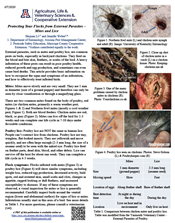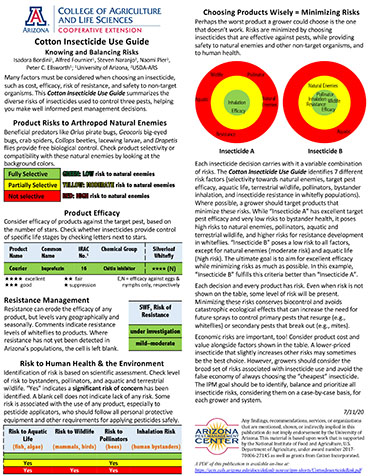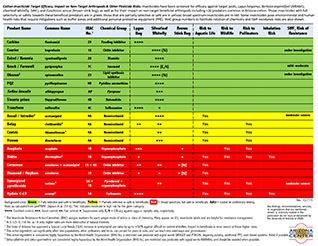-
Jul 2020External parasites, such as mites and poultry lice, are common pests on birds, especially in backyard chickens. They feed on the blood and bite skin, feathers, or scales of the bird. A heavy infestation of these pests can result in poor poultry health, reduced growth and egg production, and sometimes can even cause bird deaths. This article provides basic information on how to recognize the signs and symptoms of an infestation, and how to effectively treat infested birds.
-
Jul 2020This publication is the Spanish-language translation of the IPM Short, Protecting your Flocks from External Parasites - Mites and Lice.
-
Jul 2020Many factors must be considered when choosing an insecticide, such as cost, efficacy, risk of resistance, and safety to non-target organisms. This Cotton Insecticide Use Guide summarizes the diverse risks of insecticides used to control three pests, helping you make well informed pest management decisions.
-
Jun 2020Cotton insecticide target efficacy, impact on non-target arthropods and other pesticide risks.
-
Oct 2019
The Arizona Pest Management Center uses scientific data and feedback from grower communities to develop comments that inform Environmental Protection Agency (EPA) pesticide registration decisions. Our analysis shows that a high percentage of our comments provide substantive information that influence registration outcomes.
-
May 2019Off target movement of the auxin herbicides, 2,4-D and dicamba, will cause substantial injury to downwind, sensitive crops such as cotton, grapes, melons and other broadleaf plants. This publication provides guidelines for preventing off target movement.
-
May 2019Spray Legally: Summary of Enlist™, Engenia® and Xtendimax® Application Use Requirements on Cotton (PDF, 1 MB)This publication summarizes best use practices and label requirements for auxin herbicides.
-
Jun 2018The Agricultural Handlers Exposure Task Force (AHETF) discovered some improper practices that caused unnecessary exposure to mixer/loaders using Water Soluble Packaging (WSP). The AHETF reported their findings and presented the EPA with a list of best management practices to help minimize exposure caused by these improper practices.
-
Aug 2017Tick and flea collars are long-term pest control products for your pets. They kill pests or deter them from living and feeding on your pets. Some products last for 3 months, while others are effective for 8 months. The chemistries in these collars are designed to work on pests while reducing the possibility of negative side effects for you and your pets. But, exposure to these ingredients can be hazardous.
-
Aug 2017Four organic insecticides were recently found to be contaminated with several synthetic insecticides by the Oregon Department of Agriculture (ODA). ODA is now working to identify the source of contamination for these insecticides.
-
Jun 2016Accurate data on agricultural pesticide use in Arizona has many uses that benefit grower communities. The accuracy of pesticide use data impacts the quality of UA outreach, publications and reports. This short provides tips and resources to help improve data quality.
-
Jan 2016Pesticide labels contain a lot of information and can be overwhelming. But reading and understanding pesticide labels is essential to ensuring safe and effectiveuse of pesticides. Further, it is a federal crime to use a pesticide in any way that is not consistent with label instructions.
-
Jun 2015Insecticide resistance threatens economic and effective pest control, especially when chemistries are used to target a common pest across multiple crops such as whiteflies. Difficulty in discovery of new chemistries and increasing costs of regulation of new chemistries make it essential that we preserve and extend the life of the currently available modes of action through integrated resistance management (IRM) programs.
-
Jul 2012A probable case of glyphosate (Roundup) resistant Palmer Amaranth was discovered in an Arizona cotton field where glyphosate was the only herbicide used. Seed collection and testing later confirmed resistance. This short provides important tips to delay the spread of resistance.



-(002)_page_3.jpg?sfvrsn=cda1d0dc_0?size=300)





d726e4b5838c4e258908ac21d4d90c2b.png?sfvrsn=753dc26e_0?size=300)









